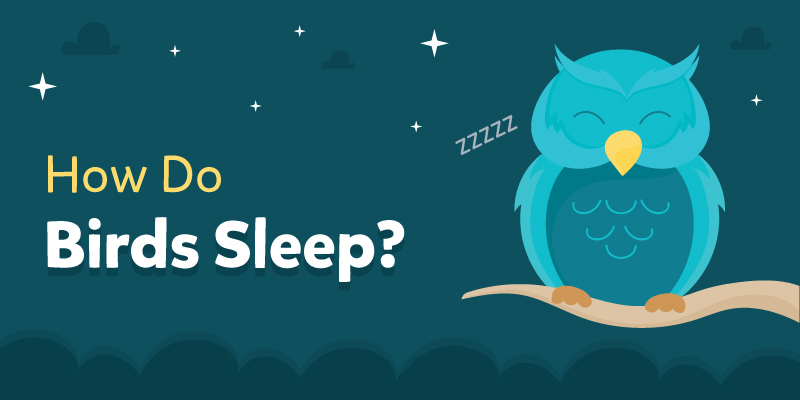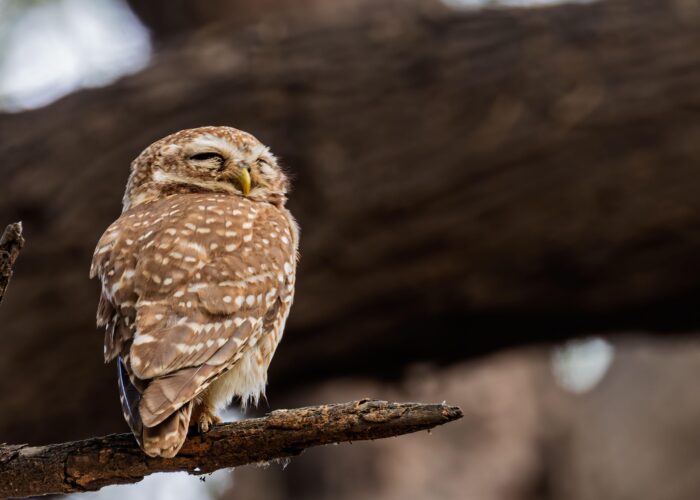
Some of life’s simplest mysteries can prove the hardest to solve. One such mystery is how a bird sleeps, especially while it’s perched so precariously on a branch? Or for that matter, how is it able to hang upside down on a tree branch for a snooze, like a parrot?
Although birds do sleep, they don’t sleep quite like us humans.
First of all, they sleep for a lot less time than we do. Humans, and many mammals overall, have longer sleep cycles than that of birds. REM sleep, the part of the sleep cycle when we are in the deepest sleep (and also when we dream), lasts for several minutes in mammals, but hardly 10 seconds in birds. In other words, birds sleep by basically taking mini-naps.

Apart from flying, birds have another amazing ability – they can sleep with one eye open. This allows them to modulate how intensely they sleep.
The eye that is open is connected to the opposite hemisphere. So, if the right eye is open, the left hemisphere of the brain is awake, and vice versa. This light and flexible style of sleeping allows birds to flee from a predator on a moment’s notice, even when they’re in the middle of a nap.
To fully sleep, a person needs to relax. The same is true for most other animals. But in birds it’s not quite like that. For a good full sleep, they need leg tension.
If the bird’s legs are not strained, it may not even fall asleep. Thanks to this adaptation, birds can protect themselves from falling from branches even in strong winds or bad weather.
The tension of the legs when landing on a perch or branch promotes sleep, and at the same time provides them with perfect balance. The risk of falling in such a situation is virtually zero.
And even if such an incident happens, and the bird is knocked down by a gust of wind, it will immediately wake up and spread its wings before it even touches the ground. After all, this is also an instinct.
It would seem that standing on legs for many hours could cause discomfort, pain, and numbness. However, birds do not suffer at all from such things. Indeed, the legs of birds have a very special structure.
The muscles of the legs are connected to the fingers with the help of special tendons. A tendon is a connective tissue that attaches muscle to bone.

When landing on a branch, there is a contraction in the muscles of the legs, and the muscles pull on these tendons. Accordingly, the paws are bent from this. And in the end, until the bird transfers its weight from its paws to its wings, its fingers simply will not be able to straighten naturally.
This eliminates any discomfort from sitting for long hours on a branch. After all, the main load falls on the tendon, thus removing any discomfort to our birdie.
After waking up, the bird rises slightly, which causes relaxation of the muscles and tendons. The wings then open and it flies away.
However, you should know that not all birds need to sit on a branch to sleep. Some birds choose completely different forms of recreation.
Land birds, for the most part, do not care where, how, and in what position they sleep. Since they do not sit on a branch, their fingers and tendons do not form any lock.
This applies to ostriches, ducks, geese, other land and aquatic inhabitants.
Some birds tend to sleep exclusively in nests, and in specially prepared adaptive places.
Flamingos and some storks like to stand on one leg, hiding the second in their plumage. They spend so much time in water that they can sleep in this position without any problems.

Credit: Christopher Woods, via Wikimedia Commons
The balance mechanism of such birds is developed to such an extent that standing on one leg for hours does not cause them any discomfort, and they certainly will not fall in a dream.
While on the one hand these birds sleep while standing still, on the other hand storks can sleep on the fly. After all, they have to make seasonal flights over significant distances, and they really need an additional opportunity for sleep at such moments.
These birds generally do not land for years. So they live, eat and sleep in the air, all the while gliding towards their destination. It’s as if they are on ’autopilot’
Studying sleep patterns of birds has its own challenges. For one, birds are a diverse and eclectic bunch. Their bodies and behaviour can be vastly different, depending on which species or family they belong to. Sleep cycles differ just as widely. Comparing how an ostrich sleeps to how a sparrow or a flamingo sleep would be foolish, and likely uninformative.
Bird feet are also adapted for different purposes, so the way they stand and their feet movement might also be different.
We may not know the whole story yet, but there is no denying how remarkable it is that birds manage this balancing act every day! Speaking of sleep, do you know the importance of sleep for students?
Enjoyed reading this? Check out more such awesome content on The Learning Tree blog:
Raza has been writing since 2008, be it fiction, poetry, or articles on science, politics, and history. He believes that words can change the world, and he uses them to inspire and empower people through his writing. When he is not working, he is watching nature documentaries or playing with his cats.